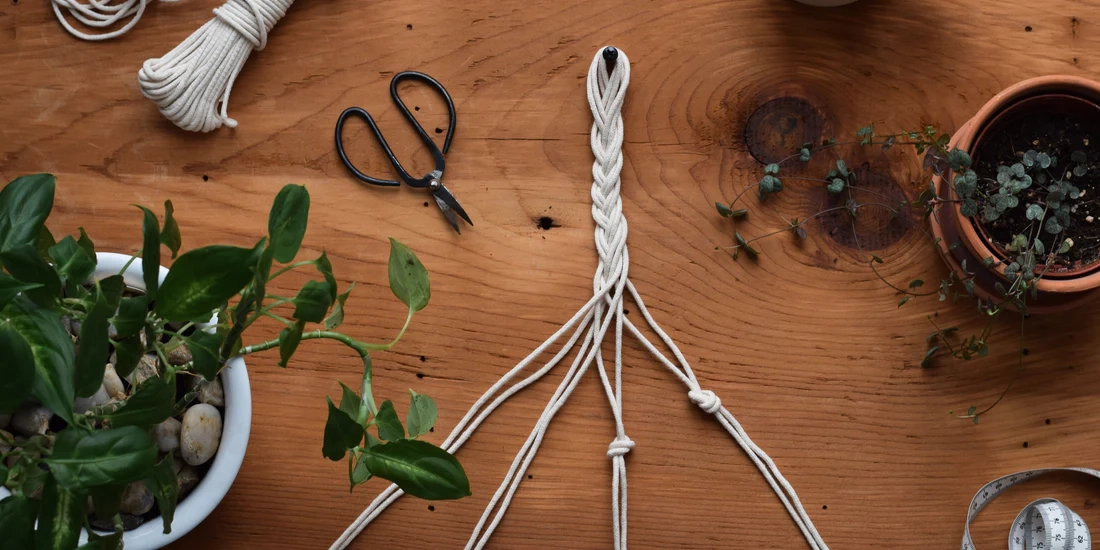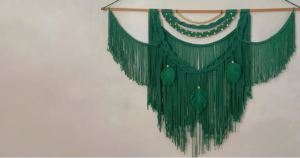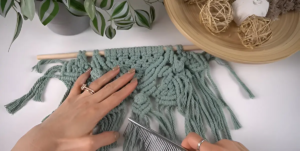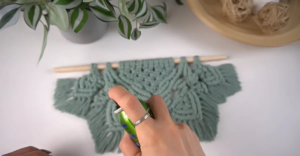Are you standing in the craft store aisle, completely overwhelmed by the dozens of cord options, wondering which materials will help you create beautiful macrame pieces without breaking your budget or crushing your confidence? This frustrating scenario faces every new macrame enthusiast, and choosing the wrong materials often leads to disappointing results that discourage beginners from continuing their creative journey.
Best macrame cord material for beginners selection represents the crucial foundation that determines whether your first projects become cherished keepsakes or expensive learning experiences. The overwhelming variety of available materials creates confusion for newcomers, leading to costly mistakes that could easily be avoided with proper guidance from experienced crafters.
This comprehensive starter guide reveals the insider secrets that professional macrame artists wish they had known when beginning their creative journey. You’ll discover exactly which materials provide the perfect balance of workability, affordability, and stunning results that build confidence while developing essential skills.
Prepare to unlock the knowledge that transforms overwhelming material choices into clear, confident decisions that guarantee project success. Your macrame adventure begins with making smart material choices that set you up for immediate wins and long-term creative satisfaction!
Understanding the Best Macrame Cord Material for Beginners: Foundation Principles
Best macrame cord material for beginners must balance multiple factors including ease of handling, forgiving characteristics, reasonable cost, and versatility across different project types. These foundational materials should encourage experimentation while building confidence through consistent, predictable results that showcase developing skills effectively.
The ideal beginner materials possess specific characteristics that make learning enjoyable rather than frustrating. Soft, pliable cords work easily without causing hand fatigue, while consistent diameter and quality prevent unexpected problems that discourage new crafters from continuing their creative exploration.
Professional instructors consistently recommend starting with proven materials that have helped thousands of beginners achieve success. These time-tested options eliminate guesswork while providing the stable foundation necessary for skill development and creative growth throughout your macrame journey.
Key Characteristics of Beginner-Friendly Materials
Understanding essential material properties enables informed decision-making when selecting the best macrame cord material for beginners across diverse skill levels and project interests. These fundamental characteristics directly impact both learning experience and project outcomes for newcomers to the craft.
Softness and flexibility significantly affect working comfort and technique development, as harsh or stiff materials create hand fatigue and make knot formation difficult for developing muscle memory. Premium beginner materials feel pleasant to handle while responding predictably to manipulation and tension adjustments.
Consistent diameter throughout cord length prevents unexpected variations that create uneven tension and irregular knot appearance. Quality beginner materials maintain uniform thickness that enables consistent results while building confidence through predictable performance characteristics.
Tangle resistance becomes crucial for beginners who may work more slowly while learning proper technique. Materials that resist tangling reduce frustration and project delays while allowing focus on skill development rather than material management challenges.
Cotton: The Ultimate Best Macrame Cord Material for Beginners
Cotton represents the gold standard when selecting the best macrame cord material for beginners due to its exceptional combination of workability, affordability, availability, and forgiving characteristics that make learning enjoyable and successful. This natural fiber has introduced more people to macrame than all other materials combined.
Single-strand cotton provides excellent flexibility and softness that feels comfortable during extended crafting sessions while maintaining sufficient strength for most beginner projects. The natural fiber characteristics create pleasant tactile experiences that encourage continued exploration and skill development.
Twisted cotton constructions offer enhanced durability while maintaining beginner-friendly working properties. These materials provide excellent definition for knot work while forgiving minor tension inconsistencies that commonly occur during the learning process.
Cotton Cord Weight Selection
3mm cotton cord represents the optimal starting point for the best macrame cord material for beginners, providing the perfect balance between ease of handling and knot definition that showcases developing skills effectively. This versatile size works well for wall hangings, plant holders, and decorative accessories.
4mm alternatives offer slightly enhanced visibility for knot work while remaining comfortable for extended use. This size works particularly well for beginners with vision concerns or those preferring more substantial cord feel during manipulation and knotting procedures.
5mm cotton becomes appropriate for larger projects once basic skills develop, though some beginners may find this size initially challenging for detailed work. The increased bulk requires more hand strength while providing impressive visual impact for successful completions.
2mm options work well for jewelry and delicate projects but may frustrate absolute beginners due to increased precision requirements and reduced visual feedback during knot formation and pattern development.
Quality Indicators for Beginner Cotton Selection
Premium cotton exhibits consistent coloration throughout the entire length without streaking, fading, or uneven dye penetration that creates visual distractions in finished projects. Quality materials maintain uniform appearance that showcases knot work effectively while building confidence through professional-looking results.
Proper twist tension creates materials that maintain structural integrity while working easily without excessive stiffness or unwanted unraveling during handling. The best macrame cord material for beginners demonstrates consistent twist characteristics that provide predictable working properties throughout project completion.
Natural cotton scent indicates fresh, properly stored materials without chemical odors or musty smells that suggest quality problems or inappropriate storage conditions. Fresh materials work more pleasantly while providing optimal performance characteristics for learning applications.
Minimal fiber shedding during handling indicates quality manufacturing processes and appropriate fiber selection. Excessive shedding creates messy work environments while potentially indicating weak or poorly processed materials that may affect project longevity.
Alternative Natural Fiber Options
Hemp: Rustic Appeal for Nature-Loving Beginners
Hemp provides excellent alternative characteristics when selecting the best macrame cord material for beginners interested in sustainable, environmentally friendly options with unique aesthetic properties. This natural fiber offers superior strength while maintaining beginner-friendly working characteristics.
Organic hemp appeals to environmentally conscious crafters seeking sustainable material options that align with personal values while providing excellent performance characteristics. The natural processing methods create materials with distinctive textures and earth-tone colors that enhance rustic project themes.
Hemp durability exceeds cotton alternatives while maintaining reasonable costs and excellent availability through specialty retailers and online suppliers. This longevity makes hemp an economical choice for beginners planning multiple projects or functional items requiring enhanced durability.
Working properties of quality hemp closely match cotton alternatives while offering unique texture and appearance characteristics that create distinctive finished projects. The slightly coarser feel may appeal to crafters preferring more substantial material sensations during handling and knotting.
Jute Considerations for Budget-Conscious Beginners
Jute represents the most economical option when selecting the best macrame cord material for beginners with strict budget constraints, though certain limitations require consideration before making purchasing decisions. This natural fiber provides basic functionality while maintaining minimal investment requirements.
Availability advantages make jute accessible through general craft stores and home improvement centers where specialty macrame materials may not be stocked. This convenience factor appeals to beginners wanting immediate material access without special ordering or waiting periods.
Texture characteristics of jute create rustic, natural appearances that work well for outdoor projects, garden applications, and casual home décor items. However, the coarser feel may prove less comfortable for extended crafting sessions compared to premium cotton alternatives.
Color limitations restrict jute primarily to natural tan shades, though some suppliers offer basic color options including brown and white variations. These earth tones complement rustic themes while limiting design flexibility for colorful projects.
Synthetic Alternatives for Specific Applications
Polypropylene for Outdoor Learning Projects
Synthetic materials become relevant when selecting the best macrame cord material for beginners planning outdoor applications or projects requiring enhanced durability under challenging conditions. Polypropylene offers unique advantages for specific learning situations and environmental requirements.
Weather resistance characteristics make polypropylene ideal for garden projects, outdoor decorations, and learning applications where materials may face moisture exposure or temperature fluctuations. These synthetic properties eliminate concerns about material degradation during extended outdoor display or storage.
Consistent manufacturing quality provides uniform characteristics that ensure predictable working properties throughout project completion. Synthetic materials typically demonstrate superior consistency compared to natural alternatives while maintaining reasonable costs for beginner applications.
Color variety in synthetic options exceeds natural fiber alternatives while providing excellent colorfastness under challenging environmental conditions. These characteristics appeal to beginners interested in vibrant projects that maintain appearance throughout extended use periods.
Polyester Blend Options
Blended materials combine natural fiber working properties with synthetic durability benefits when selecting the best macrame cord material for beginners seeking compromise solutions. These hybrid options provide balanced characteristics that address multiple requirements simultaneously.
Cotton-polyester blends maintain comfortable handling characteristics while improving strength and longevity compared to pure natural fibers. The synthetic content reduces costs while enhancing performance for functional projects requiring enhanced durability expectations.
Working properties of quality blends closely approximate pure cotton alternatives while providing additional benefits including reduced shrinkage, improved colorfastness, and enhanced resistance to environmental factors that affect pure natural materials.
Availability through mainstream retailers makes blended options accessible without specialty sourcing while maintaining reasonable costs appropriate for beginner budgets and experimental learning approaches.
Essential Tools and Accessories for Beginners
Basic Tool Requirements
Successful macrame projects require minimal specialized tools when working with the best macrame cord material for beginners, making this craft accessible without significant initial investment in equipment or workspace preparation. Basic household items often suffice for initial learning and skill development.
Sharp scissors represent the most essential tool for clean cord cutting and finishing techniques. Quality scissors prevent frayed cuts that compromise project appearance while enabling precise material preparation for consistent results throughout learning projects.
Measuring tools including rulers or tape measures ensure accurate cord lengths and consistent project proportions. Proper measurement prevents material waste while ensuring sufficient cord availability for project completion without frustrating shortages during critical phases.
Comfortable workspace setup reduces fatigue while encouraging extended crafting sessions that build skills effectively. Proper lighting, seating, and material organization contribute significantly to enjoyable learning experiences and successful project outcomes.
Optional Enhancement Tools
Advanced tools become useful as skills develop and project complexity increases beyond basic learning applications. These optional items enhance efficiency and results while remaining unnecessary for initial skill development and basic project completion.
Macrame boards provide consistent working surfaces with measurement guides that improve project accuracy and speed. However, beginners can successfully complete projects using cardboard alternatives or working directly on flat surfaces without specialized boards.
Comb tools help separate and arrange cords for specific techniques, though fingers work adequately for most beginner applications. These specialized tools become more valuable as skills advance and project complexity increases beyond basic learning requirements.
T-pins secure work in progress while enabling tension adjustments and pattern corrections. Straight pins or safety pins provide adequate alternatives for beginners without investing in specialized macrame pins immediately.
Project Selection for Skill Development
Ideal First Projects Using Best Macrame Cord Material for Beginners
Simple wall hangings represent perfect first projects for developing fundamental skills while creating attractive finished pieces that build confidence and demonstrate progress. These projects utilize basic knots while producing visually appealing results that encourage continued learning.
Keychains and small accessories provide quick satisfaction while building muscle memory for essential knot techniques. The small scale reduces material costs while enabling multiple practice attempts that reinforce learning without significant time investment per project.
Plant holder projects introduce functional applications while requiring slightly more complex techniques that build upon basic skills. These projects provide practical value while demonstrating the versatility possible with the best macrame cord material for beginners and proper technique development.
Coaster projects combine functionality with skill building while requiring minimal material investment and time commitment. These practical items make excellent gifts while providing opportunities to practice tension control and pattern consistency.
Progressive Skill Building Approach
Systematic skill development through carefully planned project sequences maximizes learning efficiency while building confidence through consistent success experiences. This structured approach prevents overwhelming beginners while ensuring solid foundation development.
Basic knot mastery should precede complex pattern attempts, with each new technique building upon previously learned skills. This progressive approach ensures solid understanding while preventing frustration from attempting advanced techniques prematurely.
Project complexity increases gradually through material quantity, pattern intricacy, and technique combinations that challenge developing skills appropriately. Each completed project should introduce one or two new elements while reinforcing previously learned techniques.
Documentation of completed projects through photos and notes creates valuable reference materials while providing motivation through visible progress records. This documentation helps identify successful techniques and areas needing additional practice.
Budget Planning and Cost Management
Initial Investment Considerations
Starting macrame requires minimal financial investment when selecting the best macrame cord material for beginners and essential tools wisely. Budget planning enables sustainable learning without overwhelming initial expenses that might discourage continued participation.
Material costs for beginning projects typically range from $15-30 for sufficient cord to complete multiple learning projects. This reasonable investment provides extensive practice opportunities while building skills necessary for more ambitious future projects.
Tool investments remain minimal with basic scissors and measuring tools representing the only essential purchases. Optional tools can be added gradually as skills develop and project complexity increases beyond basic learning requirements.
Quality balance becomes important as extremely cheap materials may create frustrating learning experiences while premium options exceed beginner needs unnecessarily. Mid-range materials typically provide optimal combinations of performance and value for learning applications.
Long-term Cost Efficiency
Bulk purchasing becomes economical once preferred materials are identified through initial learning experiences. Larger quantities reduce unit costs while ensuring consistent supply for multiple projects without repeated purchasing decisions.
Project planning reduces waste through accurate material estimation and efficient cutting layouts. Proper planning prevents over-purchasing while ensuring adequate materials for project completion without frustrating shortages.
Skill development enables more efficient material utilization while reducing waste through improved technique and fewer mistakes. Advanced skills justify investment in premium materials that provide enhanced results and working experiences.
Common Beginner Mistakes and Solutions
Material Selection Errors
Choosing inappropriate cord weights represents the most common mistake when selecting the best macrame cord material for beginners, leading to difficult working conditions and disappointing results. Understanding proper weight selection prevents frustration while ensuring successful learning experiences.
Extremely thin cords create precision challenges that frustrate beginners while providing minimal visual feedback during knot formation. Starting with appropriate weights enables clear technique visualization while building confidence through successful completions.
Overly thick materials prove difficult to manipulate while requiring excessive hand strength that creates fatigue during learning sessions. Proper sizing enables comfortable working while maintaining reasonable project timelines that encourage continued participation.
Poor quality materials with inconsistent characteristics create unpredictable working conditions that interfere with skill development. Quality material selection eliminates variables while enabling focus on technique mastery rather than material management challenges.
Technique Development Issues
Tension inconsistency represents the primary technical challenge facing beginners learning macrame techniques. Understanding proper tension control significantly improves results while reducing frustration during skill development phases.
Over-tightening creates rigid, uncomfortable projects while making subsequent knot formation difficult or impossible. Proper tension creates comfortable, drapeable finished pieces while maintaining working ease throughout project completion.
Under-tightening produces loose, sloppy appearing projects that fail to showcase knot work effectively. Consistent moderate tension creates professional appearances while maintaining reasonable working comfort throughout extended crafting sessions.
Pattern following difficulties often result from attempting complex projects prematurely before mastering fundamental techniques. Progressive skill development through appropriate project selection prevents overwhelming challenges while building solid foundations.
Frequently Asked Questions
What specific weight and material should absolute beginners choose for their very first macrame project?
Start with 3mm single-strand cotton cord, which provides the perfect balance of workability and visual results for beginners. This weight is comfortable to handle during extended crafting sessions while producing clear knot definition that showcases your developing skills. Cotton feels pleasant to work with, costs less than premium materials, and forgives minor tension inconsistencies common during learning. Avoid starting with materials thinner than 2mm or thicker than 4mm, as these sizes create unnecessary challenges that can discourage continued learning.
How much cord should I buy for my first few practice projects, and what’s a reasonable budget for getting started?
Purchase 200-300 yards of 3mm cotton cord initially, which costs approximately $20-25 and provides sufficient material for 6-8 beginner projects including wall hangings, keychains, and small plant holders. This quantity allows extensive practice without material anxiety while building essential skills. Add basic scissors ($10-15) and a measuring tape ($5), bringing your total starter investment to around $40-50. This reasonable budget provides everything necessary for several months of learning and skill development.
Can I use yarn or other household string materials instead of purchasing specialized macrame cord?
While yarn can work for basic practice, it lacks the structure and consistency needed for proper technique development and attractive results. Yarn often splits during knotting, creates fuzzy appearances, and doesn’t hold knot shapes clearly. Specialized macrame cord provides superior working properties, cleaner results, and appropriate durability for finished projects. The modest cost difference between craft store yarn and quality macrame cord justifies investing in proper materials that ensure successful learning experiences and attractive finished projects.
Which colors should beginners choose, and do certain colors work better for learning than others?
Start with natural, cream, or light beige colors that provide excellent contrast for photographing your progress while clearly showing knot structure and technique details. These neutral colors complement any décor while enabling focus on skill development rather than color coordination. Avoid very dark colors initially, as they make it difficult to see knot details and identify mistakes during learning. Once basic skills develop, experiment with colors that match your personal style and intended project applications.
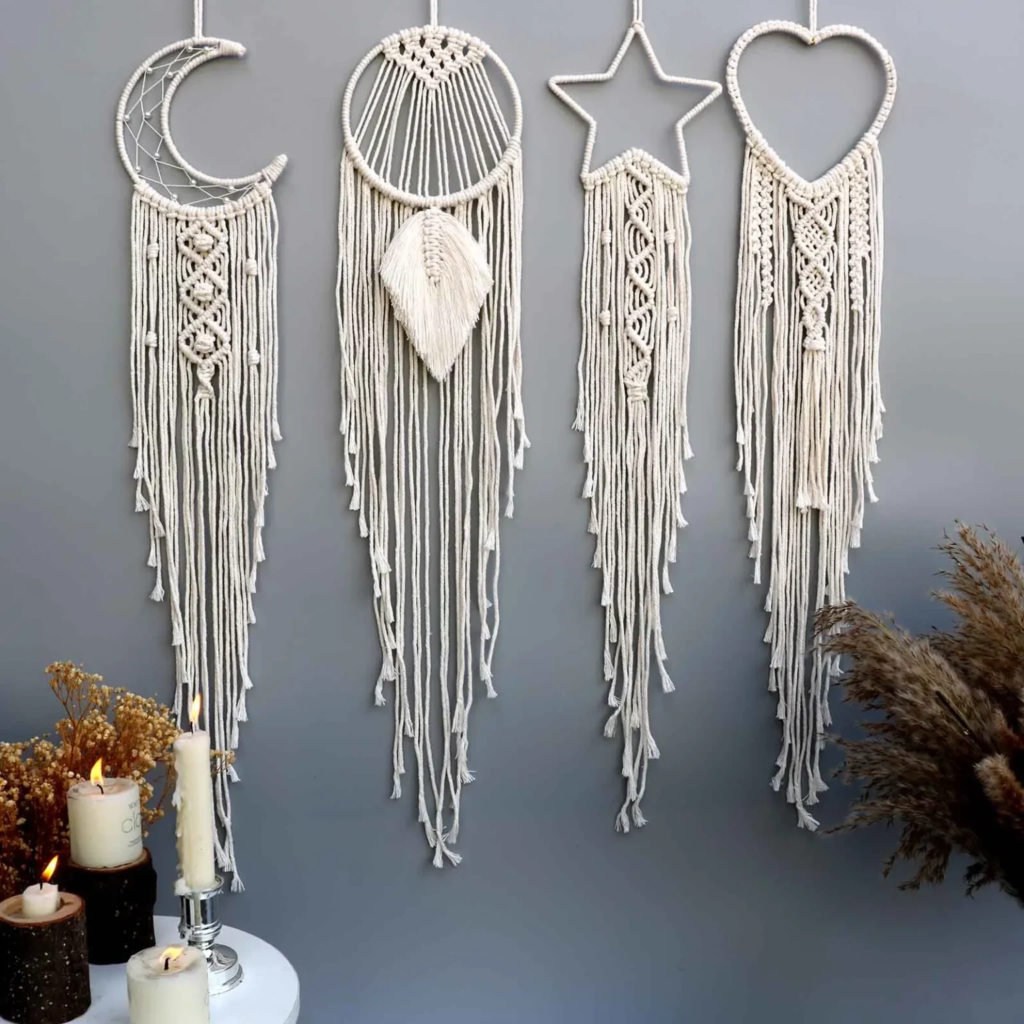
Moon Star Round Handmade Dream Catcher Macrame Wall Hanging
Are you looking for a unique and meaningful gift for yourself or your loved ones? Do you want to decorate your home with a beautiful and spiritual piece of art? If so, you will love this Moon Star Round Handmade Dream Catcher Macrame Wall Hanging.
Advanced Learning Resources and Community
Online Learning Platforms
Digital resources revolutionize macrame education for beginners seeking structured learning approaches with the best macrame cord material for beginners recommendations and technique demonstrations. These platforms provide comprehensive curriculum development while enabling learning at individual pace preferences.
Video tutorials offer visual demonstrations that complement written instructions while showing proper hand positioning, tension control, and knot formation techniques. Quality video content eliminates guesswork while providing repeatable reference materials for skill development and technique refinement.
Interactive communities enable questions, progress sharing, and expert guidance from experienced crafters willing to share knowledge and encouragement. These supportive environments provide motivation while offering solutions to specific challenges encountered during learning processes.
Pattern libraries expand creative possibilities while providing structured project progressions that build skills systematically. Access to diverse patterns prevents boredom while ensuring continuous skill development through varied technique applications and challenge levels.
Local Learning Opportunities
Craft store workshops provide hands-on instruction with immediate feedback and social learning environments that enhance skill development. These group settings enable technique comparison while building local crafting communities and ongoing support networks.
Library programs often offer free or low-cost macrame instruction using appropriate beginner materials and tools. These accessible learning opportunities eliminate cost barriers while providing expert instruction and material recommendations for continued learning.
Community college continuing education programs deliver comprehensive instruction with structured curriculum development and access to quality materials and tools. These formal learning environments provide systematic skill building while offering certificates or completion credentials.
Maker spaces increasingly offer macrame instruction and workspace access with tools and materials available for use. These shared facilities enable learning without significant initial investment while providing access to advanced tools and expert guidance.
Future Skill Development Pathways
Intermediate Progression Planning
Skill advancement requires systematic progression through increasingly complex projects that build upon fundamental techniques while introducing new challenges appropriately. Planning future learning prevents overwhelming jumps while ensuring continuous growth and engagement.
Advanced knot techniques expand creative possibilities while requiring solid foundation skills for successful execution. Proper progression timing ensures readiness for increased complexity while maintaining confidence through achievable challenges.
Larger project scales introduce new considerations including material calculation, workspace requirements, and extended timeline management. These challenges develop project management skills while expanding creative possibilities and personal satisfaction through completed accomplishments.
Mixed media integration enables creative combinations with other crafts while requiring adaptation of basic macrame techniques to new applications and material combinations.
Professional Development Possibilities
Teaching opportunities become available as skills develop and expertise grows through successful project completions and technique mastery. Sharing knowledge provides personal satisfaction while generating potential income through workshops and individual instruction.
Commissioned work possibilities emerge through demonstrated skill and quality results that attract customers seeking custom pieces. Professional applications require business skills development alongside advanced crafting techniques for sustainable success.
Product sales through craft fairs, online platforms, and retail partnerships provide income opportunities while requiring production efficiency and quality consistency for successful business development.
Design development enables creation of original patterns and techniques that contribute to the broader macrame community while establishing personal creative identity and expertise recognition.
Conclusion
Best macrame cord material for beginners selection forms the crucial foundation that determines whether your creative journey begins with confidence-building successes or frustrating disappointments that discourage continued exploration. Cotton cord in 3mm weight provides the optimal combination of workability, affordability, and forgiving characteristics that enable skill development while producing attractive results that showcase your growing abilities.
The systematic approach outlined in this guide eliminates guesswork while providing clear pathways for skill development, project selection, and material investment that maximize learning efficiency and creative satisfaction. By following these proven strategies and material recommendations, you’ll build solid foundations that support increasingly ambitious projects while developing the expertise necessary for long-term crafting enjoyment and potential professional opportunities.

